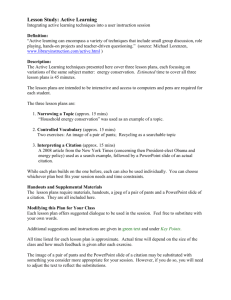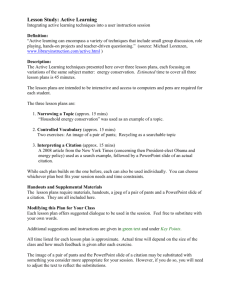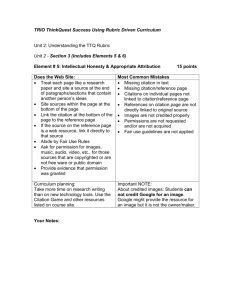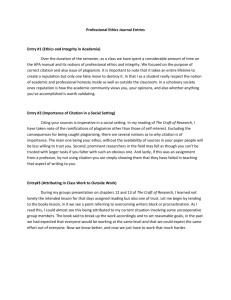Active Learning Lesson Plan - University of Michigan Library
advertisement
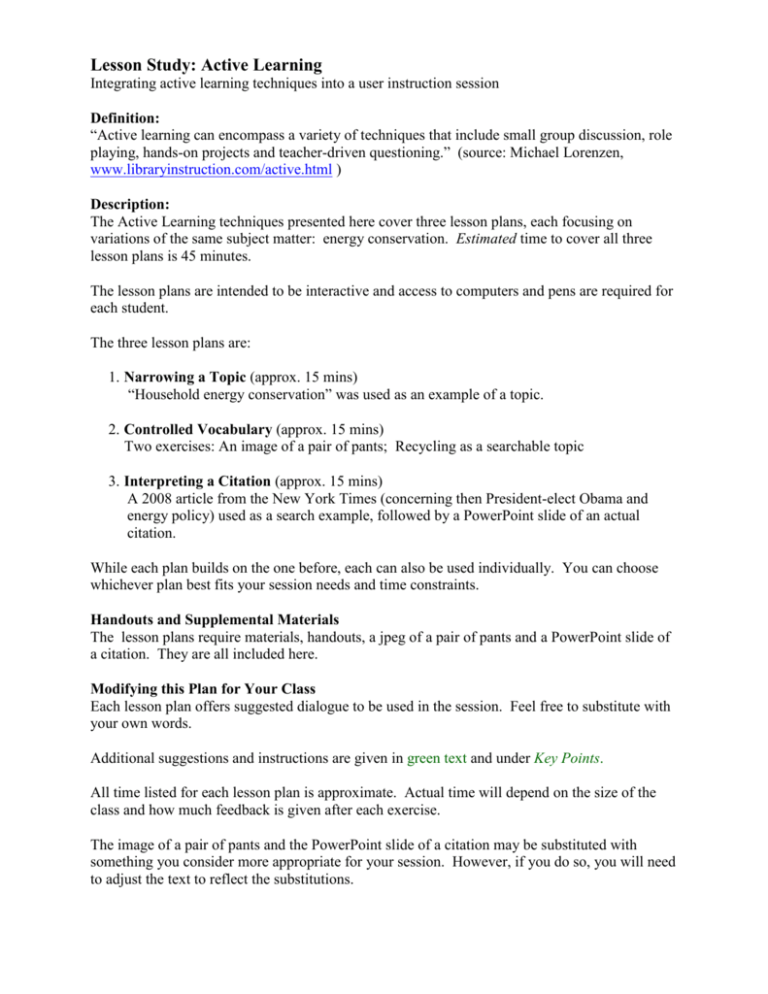
Lesson Study: Active Learning Integrating active learning techniques into a user instruction session Definition: “Active learning can encompass a variety of techniques that include small group discussion, role playing, hands-on projects and teacher-driven questioning.” (source: Michael Lorenzen, www.libraryinstruction.com/active.html ) Description: The Active Learning techniques presented here cover three lesson plans, each focusing on variations of the same subject matter: energy conservation. Estimated time to cover all three lesson plans is 45 minutes. The lesson plans are intended to be interactive and access to computers and pens are required for each student. The three lesson plans are: 1. Narrowing a Topic (approx. 15 mins) “Household energy conservation” was used as an example of a topic. 2. Controlled Vocabulary (approx. 15 mins) Two exercises: An image of a pair of pants; Recycling as a searchable topic 3. Interpreting a Citation (approx. 15 mins) A 2008 article from the New York Times (concerning then President-elect Obama and energy policy) used as a search example, followed by a PowerPoint slide of an actual citation. While each plan builds on the one before, each can also be used individually. You can choose whichever plan best fits your session needs and time constraints. Handouts and Supplemental Materials The lesson plans require materials, handouts, a jpeg of a pair of pants and a PowerPoint slide of a citation. They are all included here. Modifying this Plan for Your Class Each lesson plan offers suggested dialogue to be used in the session. Feel free to substitute with your own words. Additional suggestions and instructions are given in green text and under Key Points. All time listed for each lesson plan is approximate. Actual time will depend on the size of the class and how much feedback is given after each exercise. The image of a pair of pants and the PowerPoint slide of a citation may be substituted with something you consider more appropriate for your session. However, if you do so, you will need to adjust the text to reflect the substitutions. LESSON PLAN 1 Narrowing a Topic (15 mins) Materials needed: - Words on post-it notes - Blank post-it notes - Markers - Tape - Large blank sheets of paper - Handout – Choosing a Paper Topic You have been given an assignment to write a paper on any aspect of home energy conservation. Today in class you’ll learn some ways to narrow down the topic for that paper, how to find the words that will be most effective to use in searching for your topic, and how to interpret the citations that you find in your search results. We’ll start today by thinking about research topics. Specifically ways of thinking about the scope or realm of a topic, and methods of narrowing down or focusing to come up with a manageable topic for your paper. We will begin with a group exercise. Divide the students into groups the largest of which would include 4-5 people. Have each group gather by one of the large sheets of paper taped to the wall. Distribute word cards, blank cards, and markers to each group. You’ve been given a number of words related to the topic of household energy conservation. Now I’d like you to arrange the words in a way that helps you organize or think about the topic. Use most of the words in your packet, but you don’t have to use all of them. Arrange the words on the large sheet of paper and use the markers to indicate connections among the words, or to write additional words on the blank Post-its. This way you can illustrate connections, make your organization more complete, fill in gaps, or go in a different direction. You have (five) minutes to complete this task and then I’ll ask one (or more) of the groups to talk about your diagram and the thought processes you went through to create it. Remember there are no right or wrong answers. Give them at least three minutes, get their attention, and ask a group to report out. Depending on the time, ask other groups to report on issues not brought up by the first group. Looking at your arrangement of words, choose a piece of the larger topic that you would consider a reasonable-sized paper topic by circling the area. To help you choose, think of at least one research question that could be asked and answered around that subtopic in your paper. Write the research question or questions on your paper. Have the students sit in their seats and pass out the handout on Choosing a Paper Topic. This technique of modeling a subject could be helpful in choosing a research paper topic, whether you do it more formally or loosely, as you begin a potential topic. Representing a subject graphically can give you an idea of the context surrounding the larger topic and your narrower paper topic. It can also help reveal which topics might not work, for instance because they’re too disjointed, or would end up in frustration or a fragmented paper. Your paper may touch on areas outside your narrow sub-topic, but the bulk of it should focus on what falls within the boundaries of the sub-topic. The handout shows three possible ways of organizing concepts related to a topic that might be similar or different from what you did today. It also gives suggestions on other methods that could help you come up with a potential paper topic. Key points that should be mentioned if they don’t come out in the discussion: Specific paper and research topics exist within a larger universe of knowledge, and it’s important to understand and remember how your specific topic fits within that larger realm. This helps you to organize your paper as well as to keep in mind the research that has already been done within this larger realm. There are many ways of organizing the concepts within a larger realm. There is no one “right” way of doing this. There are also many ways of surveying the larger body of literature to find a paper topic that interest you and is the right size for your paper. LESSON PLAN 2 Controlled Vocabulary (15 mins) Materials needed: - A jpeg of a pair of pants. We’ve included one here for you but feel free to substitute with some other image. Be sure to keep the filename neutral to avoid influencing feedback from the class. Now that you have a paper topic, you’ll want to think of what terms to use when you’re searching for articles on your topic. To help understand how best to do this, we’ll try another group activity. Write the URLs for www.jcrew.com , www.overstock.com , and www.oldnavy.com on the whiteboard. Depending on how many students are in the class, break them up into small groups or have them work individually. At least one student should be looking at each of the three websites listed on the board. Assign one group or student to look at JCrew, one group or student to look at Old Navy, and one group or student to look at Overstock.com. Show the image of the pants on the screen but do not use the word pants! (Tip: article of clothing) Within the website you’ve been given, find a piece of clothing as close to this as you can. Take notes on how you’re searching so that you can describe your methods afterwards. You have one minute to do this. What terms did you use in group 1? How about Group 2? Group 3? Make a separate list for each on the white board, circling those terms/strategies that seemed successful. Which ones worked well for your site? Why? Key points to mention if they don’t come out in the discussion: Each site has its own language or vocabulary You may be using terms that make perfect sense to you, but they’re not the only ones that are right If you already know the vocabulary, this can be helpful, but it might exclude stuff you wouldn’t have seen if you’d been searching with other related terms (or browsing) Believe it or not, library databases of scholarly articles have a lot in common with these online retailer sites. Let’s now search for articles on recycling in a few different interfaces to try to identify what standardized language or terms the database uses to describe articles on this topic. Everyone should click on the home page link and go to the Search/MLibrary window. Within the search box, each group will be entering a different database. Deselect all options except Databases. On the whiteboard, write the names of the three databases to be used: Proquest Research Library, Ecology Abstracts, PsycInfo. Assign a database to each group. Pass out the worksheet. You have 3 minutes to search for articles on Recycling in the database and to fill out the worksheet. So let’s find out what you learned. What does database X call their specific language or vocabulary terms? (CSA: descriptor; EBSCO: subject words; Proquest: Topics and Subjects) Where do you see this language or vocabulary? Open the individual databases as they discuss them and try to follow along with pertinent portions of what the students are saying they did. Key points to mention if they don’t come out in the discussion: Each database uses its own controlled vocabulary Using all the subject headings that a database might use for your topic is the most effective way to get a focused list of articles that are most closely related to your topic LESSON PLAN 3 Interpreting a Citation (15 mins) Materials needed: - A PowerPoint slide of a citation - Multiple copies of an article about then President-elect Obama’s views on the environment to be distributed, one to each group. Once you’ve figured out what terms to use in a database and you’ve run your search, you get a list of citations. Let’s spend a little time now figuring out what kind of information those citations give you and why they are in a particular format. Form groups of 2 (if there is an odd number of students, have 3 students in one group). I’m going to pass out an article to one member of your group. Please don’t show the article to the other person! Pass out the copies of the article from the New York Times. For the person who has the article, imagine that you are texting the person you are paired with about an article that you saw on Obama and his views on the environment. You want that person to be able to get online and find the article. Write out the text message that you would send and pass it to your partner. Once you have the text message, get online and try to find the article. What happened when you tried to find the article? Write on the board some of the fields such as title, author, source, etc. that the students might have used to try to find the article. To the person who has the article in hand – compose a second text message providing additional information to help your partner find the article. What additional information did you send? If that wasn’t enough information what other hints could you send to help find the article? Write out the article citation on the board (for other suggestions, go to end of this section): Broder, J.M. 2008, Dec. 10. A Power meeting. New York Times (NY), p.30 So the whole point of a citation is a way to give someone the essential information they need to find the article you are mentioning to them. Citations from scholarly articles work the same way. Open the Citation PowerPoint slide. Here is a citation to a scholarly article. I want to get this particular article. Go to the home page and click on Already have a citation? Fill in this form and see if you can find a way to get to the article. Walk around and see if the students get to the article online. As you can see, the citation gives me the information I need to fill out this form. It would also give me enough information to fill out an Interlibrary Loan request form if the University Library didn’t have the journal and I needed to get the article from another library Open the ILL page and form as you say this http://www.lib.umich.edu/ill and click on the Make a Request link. Authenticate and then click on the Article request link. But how can I tell what parts of the citation will give me the pages, volume number, etc.? That’s where style guides like APA, MLA, and others come in. The style guides set down rules for where the title of an article goes in a citation, where you’ll find the volume number, how to include the publisher of a book, and so on. So you follow a style guide in order to make it easier for the next person who is looking for the article you cited to find the information that he or she needs in your citation. Key points to mention if they don’t come out in the discussion: Citations are a way to communicate the vital pieces of information that someone will need to find the item you are citing. Style guides are a way to make sure that people cite articles, chapters from books, etc. in a consistent way so that people looking at the citation will know where to find important pieces of information like page numbers, dates, etc. Does anyone have any questions about what we covered in class? Other possible topics: Charles Vlek et al about conserving energy. Lucas W. Davis about “durable goods and residential demand for energy and water.” Moser on the effects of wind direction on the distribution of insect pest populations. Elizabeth Culotta wrote an article titled, “Did Humans Learn from Hobbits?”
